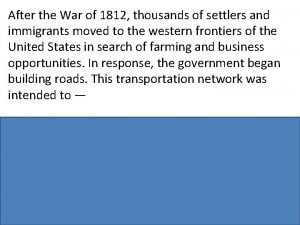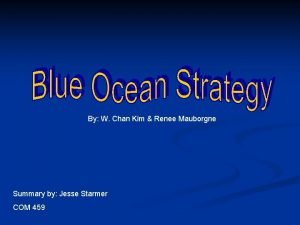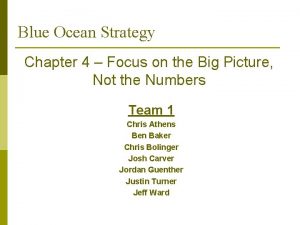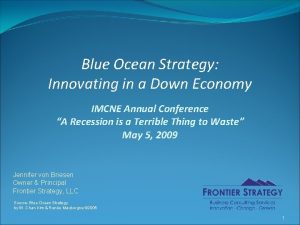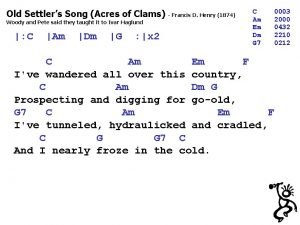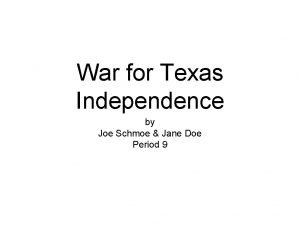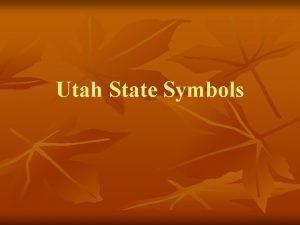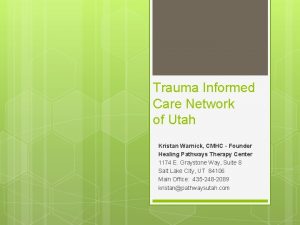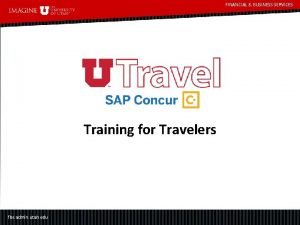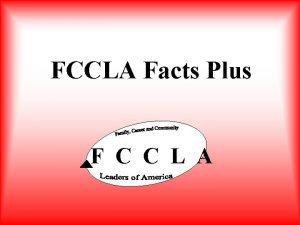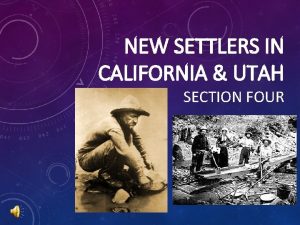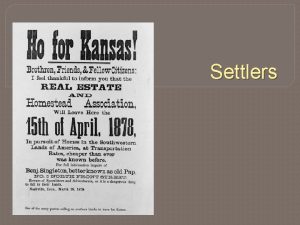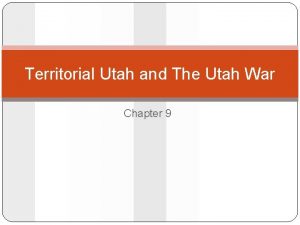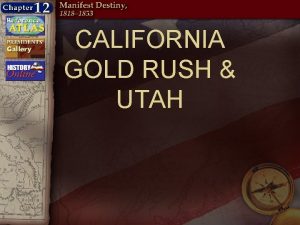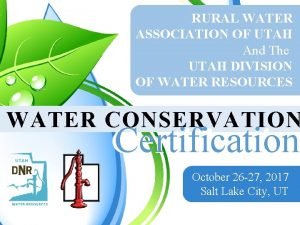New Settlers in California and Utah Chapter 12













- Slides: 13

New Settlers in California and Utah Chapter 12, Lesson 4

► On Prologue January 24, 1848, while working for John Sutter, James Marshal discovers shiny material in a ditch. § Sutter determined that it was gold. § Sutter attempted to keep it secret but everyone soon found out. ► This leads to the great California Gold Rush.

California Gold Rush Many people made their way to California to find riches. § Over 80, 000 came looking for gold in 1849 alone. ► Those who arrived in 1849 became known as the forty-niners. § A Monterey official said… “the farmers have thrown aside their plows, the lawyers their briefs, the doctors their pills, and the priests their prayer books, and all are now digging gold. ” § By the end of 1848, they had taken $6 million in gold from the American River. ► Many came to California by sea or traveling overland through the Oregon Trail or the Santa Fe Trail, then pushing through California’s Sierra Nevada mountain range. ► Americans were roughly 80% of the forty-niners. ► Others came from Mexico South America, Europe, and Australia. § 300 arrived from China, becoming the largest group of Asian immigrants to come to America. ► Some returned to China, but the other remained, establishing California’s Chinese American community. ►

The Californios ► Treaty of Guadalupe Hidalgo – Ended the war with Mexico and made Californios (Hispanic Californians) citizens of the U. S. § Also guaranteed rights to their lands but would soon be weakened. ► The Land Law of 1851 – sets up a group of people to review the Californio’s land rights. § They essentially had to prove what land they owned. § When a new settler claimed the right’s to a Californio’s land it was disputed in court. ► Some got their land back, others did not.

Life in California ► As people arrived to a new area to look for gold they built new communities, often overnight, known as boomtowns. § Only two houses existed on the Yuba River in September 1849, until a miner arrived the next year to find a town of 1, 000 people, bringing with him hotels, stores, groceries, bakeries, and gambling houses. ► These towns received colorful names like Shinbone and You Bet. People arriving by ship helped San Francisco grow from a tiny village to a city of about 20, 000 people. ► Most of the hopeful forty-niners had no idea how to even mine. ► § Went from one hillside to another using pickaxes and shovels § Spent countless hours bent over streambeds “washing” or “panning” the water for gold dust or nuggets.

Life in California ► The California Gold Rush more than doubled the world’s supply of gold. § For all their efforts, few of the forty-niners had lasting wealth. Most of the miners never found little to no gold. ► The others gambled away or spent all that they had. ► ► Merchants made huge profits. § They could charge as much as they liked since they were the only places to get certain materials from. § Eggs were sold for $10 a dozen. ► Levi Strauss – Jewish man who sold sturdy pants to miners made out of denim. § His “Levi’s” made him rich.

Gold Rush Society ► Few women lived in mining camps, mostly populated by men of all races and walks of life. Lonely and suffering from the hardships of mining, men spent their time fighting, gambling, and drinking. ► These towns had no police or prisons and lawbreakers posed a serious threat to business and owners and miners. ► Some citizens formed vigilance committees. § Vigilantes – People who take the law into their own hands, acting as police, judge, jury, and executioner. ►

Economic and Political Progress ► The Gold Rush ended after a few years but had lasting effects on California’s economy. § Agriculture, shipping, and trade expanded to meet the miner’ needs for food and other goods. § Many of those who sought gold remained either running a business or working on a farm. ► California’s population went from 20, 000 in 1848 to more than 220, 000 only four years later. § This growth resulted in the need for a more effective government. ► Zachary Taylor the Mexican War Hero ( and now president) urged the people of California to apply for statehood. § In 1849, they choose representatives to write a state constitution. § One approved, they followed by electing a governor and state legislators. § They applied for Statehood in 1850, but it caused a crisis for banning slavery in their constitution.

Economic and Political Progress ► The South objected to California becoming a state because it would upset the balance between slave states and free states. § It did not become a state until Congress worked out a compromise six months later.

A Religious Refuge in Utah ► A visitor to the Utah Territory in the 1850 s wrote admiringly, “The whole of this small nation occupy themselves as usefully as the working bees of a hive. ” § He was referring to the Mormons (Members of the Church of Jesus Christ of Latter-day Saints. ) ► They came to fulfill their vision of the godly life.

The First Mormons Joseph Smith (1830) – Founded the church in New York State claiming he had visions of launching a new Christian church. § Intended to use these visions to build an ideal society. § He believed property should be held commonly. § He supported the idea of polygamy (Men could have more than one wife) ► This angered many people and eventually gave up this practice. § He formed a community in New York, but unsympathetic neighbors were not okay with the religion, forcing them to move on. ► From New York the Mormons moved to Ohio, then Missouri, and then Illinois. § In Illinois a mob killed Smith, and Brigham Young took over as head of the church. ► Young decides the Mormons should move near the Great Salt Lake in present-day Utah. § Although part of Mexico during that time, Mexicans did not live their due to the harsh terrain of the region. ►

A Haven in the Desert ► ► The Mormon migration to the Great Salt Lake area began in 1846. § 12, 000 made the trek, becoming the largest single migration in American History. § They began to set up communities in the desert in an area they called the Deseret. Through their hard work, they made a place like Deseret flourish. § They built town carefully and irrigation canals to water their farms. § They founded industries to become self-sufficient selling supplies to forty-niners passing through Utah on their way to California. The U. S. acquired the Salt Lake area I 1848 after the war with Mexico. § In 1850, Congress established the Utah Territory and, Millard Fillmore made Brigham Young the governor. Utah did not easily incorporate into the U. S due to conflicts with federal officials. § War almost broke out between Mormons and the U. S. Army. § Utah would not become a state until 1896.

 After the war of 1812 thousands of settlers
After the war of 1812 thousands of settlers Buyer utility map
Buyer utility map Blue water strategy
Blue water strategy Village settlers
Village settlers Frp settler
Frp settler Pioneer migrator settler map example
Pioneer migrator settler map example Acres of clams song
Acres of clams song Why did settlers in texas rebel against mexican rule?
Why did settlers in texas rebel against mexican rule? What did spanish settlers hope to find in venezuela
What did spanish settlers hope to find in venezuela Chapter 16 toward a new heaven and a new earth
Chapter 16 toward a new heaven and a new earth Utah state animal
Utah state animal Trauma awareness and treatment center utah
Trauma awareness and treatment center utah University of utah financial and business services
University of utah financial and business services What does star stand for?
What does star stand for?
